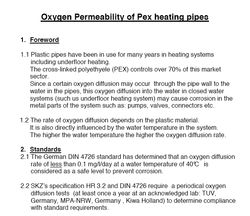millerblt said:
After reading all of the posts on O2 barrier pex I started to get curious myself is there is a difference? I have a machine designed to test for leaks in any material, we weld aircraft engine parts and have to test them for leaks when we have completed our work. The tester draws a vacuum on the part and then we flood the outside of the part with Helium, if the parts leak the Helium is detected by a mass spectrometer inside the machine.
This morning my curiosity got the better of me and I tested a piece of my underground O2 barrier pex and as I suspected I detected no leaking at the maximum rate my machine will detect Helium, ( 1x10-9 torr ).
As Helium molecules are much smaller than O2 molecules I would think this is an almost perfect protection, although every material leaks to some extent. This machine is closely calibrated as we do use it daily for all the major aircraft engine manufactures including the space shuttle. Although I do not have a piece of non barrier pex to test my guess based on other plastics I have tested is that I would get the same results if I tested the non barrier pipe.
I will try to find some non barrier to test and post my results if I can. There might be more to this than I am aware but I thought I would share my test results.
A couple things have been mentioned to make sure this would be a fair test, so I'll summarize: (plus add a couple)
- The length of the tube is very important. If an actual system has hundreds of feet and you test a foot or so of length that's greater than 100x difference, so you could get misleading results.
- Temperature is critical. You'd really want to get the pipe up to 180* or so.
- Time is also very important. The issue is not leaks, so you shouldn't expect a quick result. Diffusion is a slow process. I don't know the numbers, but you might need to wait days, weeks, or maybe even more. A heating system has that much time and more.
- I assume the spectrometer can detect oxygen? If so, why not do the test with normal air. Better to remove as many variables as possible from the experiment. Plus you'd hate to get a positive result and wonder if it was just because of the helium being smaller molecules.



